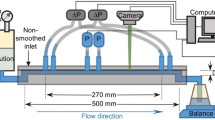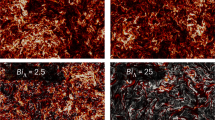Abstract
The temporal and spatiotemporal linear stability analyses of viscoelastic, subdiffusive, plane Poiseuille flow obeying the Fractional Upper Convected Maxwell (FUCM) equation in the limit of low to moderate Reynolds number (Re) and Weissenberg number (We) is reported to identify the regions of topological transition of the advancing flow interface. In particular, we demonstrate how the exponent of the power-law scaling (\(t^\alpha \), with \(0 < \alpha \le 1\)) in viscoelastic microscale models (Mason and Weitz in Phys Rev Lett 74:1250–1253, 1995) is related to the fractional order of the time derivative, \(\alpha \), of the corresponding non-linear stress constitutive equation in the continuum. The stability studies are limited to two exponents: monomer diffusion in Rouse chain melts,  , and in Zimm chain solutions,
, and in Zimm chain solutions,  . The temporal stability analysis indicates that with decreasing order of the fractional derivative (a) the most unstable mode decreases with decreasing values of \(\alpha \), (b) the peak of the most unstable mode shifts to lower values of Re, and (c) the peak of the most unstable mode, for the Rouse model precipitates towards the limit \(Re \rightarrow 0\). The Briggs idea of analytic continuation is deployed to classify regions of temporal stability, absolute and convective instabilities, and evanescent modes. The spatiotemporal phase diagram indicates an abnormal region of temporal stability at high fluid inertia, revealing the presence of a non-homogeneous environment with hindered flow, thus highlighting the potential of the model to effectively capture certain experimentally observed, flow-instability transition in subdiffusive flows.
. The temporal stability analysis indicates that with decreasing order of the fractional derivative (a) the most unstable mode decreases with decreasing values of \(\alpha \), (b) the peak of the most unstable mode shifts to lower values of Re, and (c) the peak of the most unstable mode, for the Rouse model precipitates towards the limit \(Re \rightarrow 0\). The Briggs idea of analytic continuation is deployed to classify regions of temporal stability, absolute and convective instabilities, and evanescent modes. The spatiotemporal phase diagram indicates an abnormal region of temporal stability at high fluid inertia, revealing the presence of a non-homogeneous environment with hindered flow, thus highlighting the potential of the model to effectively capture certain experimentally observed, flow-instability transition in subdiffusive flows.





Similar content being viewed by others
References
Goychuk I, Pöschel T (2020) Hydrodynamic memory can boost enormously driven nonlinear diffusion and transport. Phys Rev E 102(1):012139
Goychuk I, Pöschel T (2021) Fingerprints of viscoelastic subdiffusion in random environments: revisiting some experimental data and their interpretations. Phys Rev E 104(3):034125
Sircar S, Roberts A (2016) Ion mediated crosslink driven mucous swelling kinetics. DCDS-B 21(6):1937–1951
Coffey WT, Kalmykov PY, Waldron J (2004) The Langevin equation: with applications to stochastic problems in Physics, Chemistry and Electrical Engineering, 3rd edn. World Scientific Series in Contemporary Chemical Physics, vol. 27. World Scientific, Singapore
Rubenstein M, Colby RH (2003) Polymer Physics. Oxford University Press, New York
Sircar S, Wang Q (2009) Dynamics and rheology of biaxial liquid crystal polymers in shear flows. J Rheol 53(4):819–858
Kremer K, Grest GS (1990) Dynamics of entangled linear polymer melts: a molecular-dynamics simulation. J Chem Phys 92(8):5057–5086
Kou SC, Xie XS (2004) Generalized Langevin equation with fractional Gaussian noise: subdiffusion within a single protein molecule. Phys Rev Lett 93(18):180603
Morgado R, Oliveira FA, Batrouni GG, Hansen A (2002) Relation between anomalous and normal diffusion in systems with memory. Phys Rev Lett 89(10):100601
Vainstein MH, Lapas LC, Oliveira FA (2008) Anomalous diffusion. Technical Report
Adelman SA (1976) Fokker–Planck equations for simple non-Markovian systems. J Chem Phys 64(1):124–130
Gemant A (1938) XLV. On fractional differentials. Lond Edinb Dublin Philos Mag J Sci 25(168):540–549
Scott-Blair GW (1944) Analytical and integrative aspects of the stress-strain-time problem. J Sci Instr 21(5):80–84
Scott-Blair GW (1947) The role of psychophysics in rheology. J Coll Sci 2(1):21–32
Caputo M (1967) Linear models of dissipation whose Q is almost frequency independent-II. Geophys J Int 13(5):529–539
Bagley RL, Torvik PJ (1983) A theoretical basis for the application of fractional calculus to viscoelasticity. J Rheol 27(3):201–210
Rouse PE (1953) A theory of the linear viscoelastic properties of dilute solutions of coiling polymers. J Chem Phys 21(7):1272–1280
Tan W, Xu M (2002) Plane surface suddenly set in motion in a viscoelastic fluid with fractional Maxwell model. Acta Mech 18(4):342–349
Qi M, Xu M (2009) Some unsteady unidirectional flows of a generalized oldroyd-b fluid with fractional derivative. Appl Math Model 33:4184–4191
Fetecau C, Fetecau C, Kamran M, Vieru D (2009) Exact solutions for the flow of a generalized oldroyd-b fluid induced by a constantly accelerating plate between two side walls perpendicular to the plate. J Non-Newt Fluid Mech 189–201
Zheng L, Liu Y, Zhang X (2012) Slip effects on mhd flow of a generalized oldroyd-b fluid with fractional derivative. Nonlinear Anal RWA 13:513–523
Zhao J, Zheng L, Zhang X, Liu F (2016) Unsteady natural convection boundary layer heat transfer of fractional Maxwell viscoelastic fluid over a vertical plate. Int J Heat Mass Transfer 47:760–766
Ancey C (2020) Bedload transport: a walk between randomness and determinism. Part 1. The state of the art. J Hydraul Res 58:1–17
Zaks MA, Nepomnyashchy A (2018) Subdiffusive and superdiffusive transport in plane steady viscous flows. Proc Natl Acad Sci 116(37):18245–18250
Khalid M, Chaudhary I, Garg P, Shankar V, Subramanian G (2021) The centre-mode instability of viscoelastic plane Poiseuille flow. J Fluid Mech 915:A43
Mason TG, Weitz DA (1995) Optical measurements of frequency-dependent linear viscoelastic moduli of complex fluids. Phys Rev Lett 74(7):1250–1253
Mason TG, Gang H, Weitz DA (1996) Rheology of complex fluids measured by dynamic light scattering. J Mol Struct 383:81–90
Zimm BH (1956) Dynamics of polymer molecules in dilute solution: viscoelasticity, flow birefringence and dielectric loss. J Chem Phys 24(2):269–278
Kirkwood JG (1954) The general theory of irreversible processes in solutions of macromolecules. J Polym Sci 12(1):1–14
Schiessel H, Metzler R, Blumen A, Nonnenmacher TF (1995) Generalized viscoelastic models: their fractional equations with solutions. J Phys A 28:6567–6584
Brader JM (2010) Nonlinear rheology of colloidal dispersions. J Phys 22:363101
McKinley S, Yao L, Forest MG (2009) Transient anomalous diffusion of tracer particles in soft matter. J Rheol 53(6):1487–1506
Sircar S, Wang Q (2008) Shear-induced mesostructures in biaxial liquid crystals. Phys Rev E 78(6):061702
Sircar S, Wang Q (2010) Transient rheological responses in sheared biaxial liquid crystals. Rheologica Acta 49(7):699–717
Li J, Sircar S, Wang Q (2010) A note on the kinematics of rigid molecules in linear flow fields and kinetic theory for biaxial liquid crystal polymers. e-LC Commun
Sircar S, Li J, Wang Q (2010) Biaxial phases of bent-core liquid crystal polymers in shear flows. Commun Math Sci 8(3):697–720
Sircar S (2010) A hydrodynamical kinetic theory for self-propelled ellipsoidal suspensions. Int J Emerg Multidiscp Fluid Sci 2(4)
Sircar S, Younger JG, Bortz DM (2015) Sticky surface: sphere-sphere adhesion dynamics. J Biol Dyn 9:79–89
Sircar S, Aisenbrey E, Bryant SJ, Bortz DM (2015) Determining equilibrium osmolarity in poly (ethylene glycol)/chondrotin sulfate gels mimicking articular cartilage. J Theoret Biol 364:397–406
Sircar S, Roberts AJ (2016) Surface deformation and shear flow in ligand mediated cell adhesion. J Math Biol 73(4):1035–1052
Sircar S, Nguyen G, Kotousov A, Roberts AJ (2016) Ligand-mediated adhesive mechanics of two static, deformed spheres. Eur Phys J E 39(10):1–9
Sircar S, Bansal D (2019) Spatiotemporal linear stability of viscoelastic free shear flows: dilute regime. Phys Fluids 31(8):084104
Singh S, Bansal D, Kaur G, Sircar S (2020) Implicit-explicit-compact methods for advection diffusion reaction equations. Comput Fluids 212:104709
Bansal D, Chauhan T, Sircar S (2022) Spatiotemporal linear stability of viscoelastic Saffman–Taylor flows. Phys Fluids 34(10)
Bansal D, Ghosh D, Sircar S (2023) Selection mechanism in non-Newtonian Saffman-Taylor fingers. SIAM J Appl Math 83(2):329–353
Glockle WG, Nonnenmacher TF (1991) Fractional integral operators and Fox functions in the theory of viscoelasticity. Macromolecules 24:6426–6434
Glockle WG, Nonnenmacher TF (1994) Fractional relaxation and the time-temperature superposition principle. Rheologica Acta 33:337–343
Prodanov D (2018) Fractional velocity as a tool for the study of non-linear problems. Fractal Fract 2(1):2–23
Prodanov D (2017) Conditions for continuity of fractional velocity and existence of fractional Taylor expansions. Chaos Solitons Fractals 102:236–244
Macosko CW (1994) Rheology: principles, measurements, and applications, 1st edn. Wiley, New York
Spagnolie SE (2015) Complex fluids in biological systems: experiment, theory, and computation. Springer, New York
Jiménez AH, Santiago AMGJH, Gonzáles JS (2002) Relaxation modulus in PMMA and PTFE fitting by fractional Maxwell model. Polym Test 21:325–331
Bansal D, Ghosh D, Sircar S (2021) Spatiotemporal linear stability of viscoelastic free shear flows: nonaffine response regime. Phys Fluids 33:054106
Jaishankar A, McKinley GH (2014) A fractional k-bkz constitutive formulation for describing the nonlinear rheology of multiscale complex fluids. J Rheol 58(6):1751–1788
Huerre P, Monkewitz PA (1990) Local and global instabilities in spatially developing flows. Annu Rev Fluid Mech 22:473–537
Briggs RJ (1964) Electron-stream interaction with plasmas. MIT Press, Cambridge
Kupfer K, Bers A, Ram AK (1987) The cusp map in the complex-frequency plane for absolute instability. Phys Fluids 30(10):3075–3082
Atalik K, Keunings R (2002) Non-linear temporal stability analysis of viscoelastic plane channel flows using a fully-spectral method. J Non-Newt Fluid Mech 102:299–319
Rabaud M, Couder Y, Gerard N (1988) Dynamics and stability of anomalous Saffman-Taylor fingers. Phys Rev A 37:935–947
Larson RG (2000) Turbulence without inertia. Nature 405:27–28
Riley JJ, Hak MG, Metcalfe RW (1988) Complaint coatings. Annu Rev Fluid Mech 20:393–420
Nandagopalan P, John J, Baek SW, Miglani A, Ardhianto K (2018) Shear-flow rheology and viscoelastic instabilities of ethanol gel fuels. Exp Thermal Fluid Sci 99:181–189
Zarabadi M (2019) Development of a robust microfluidic electrochemical cell for biofilm study in controlled hydrodynamic conditions. PhD thesis, Univ. Laval
Zarabadi MP, Charette SJ, Greener J (2018) Flow-based deacidification of geobacter sulfurreducens biofilms depends on nutrient conditions: a microfluidic bioelectrochemical study. Chem Electrochem 5(23):3645–3653
Acknowledgements
T. Chauhan, D. Bansal, and S. Sircar acknowledge the financial support of the Grant CSIR 09 /1117 (0012) /2020-EMR-I and DST ECR/2017/000632, respectively.
Author information
Authors and Affiliations
Contributions
TC and DB performed the simulation and analysis. SS formulated the problem. All authors reviewed the manuscript.
Corresponding author
Ethics declarations
Conflict of interest
The authors declare that there are no conflict of interests regarding the publication of this paper.
Additional information
Publisher's Note
Springer Nature remains neutral with regard to jurisdictional claims in published maps and institutional affiliations.
Appendix A: Viscoelastic dispersion relation
Appendix A: Viscoelastic dispersion relation
The expressions, \(M_i\), utilized in the viscoelastic dispersion relation outlined in Sect. 2.2, is given as
Rights and permissions
Springer Nature or its licensor (e.g. a society or other partner) holds exclusive rights to this article under a publishing agreement with the author(s) or other rightsholder(s); author self-archiving of the accepted manuscript version of this article is solely governed by the terms of such publishing agreement and applicable law.
About this article
Cite this article
Chauhan, T., Bansal, D. & Sircar, S. Spatiotemporal linear stability of viscoelastic subdiffusive channel flows: a fractional calculus framework. J Eng Math 141, 8 (2023). https://doi.org/10.1007/s10665-023-10282-7
Received:
Accepted:
Published:
DOI: https://doi.org/10.1007/s10665-023-10282-7




